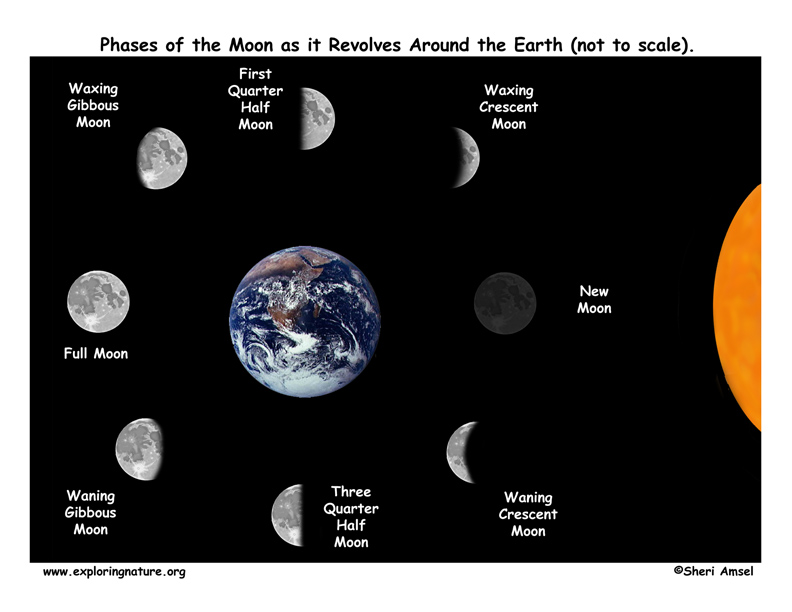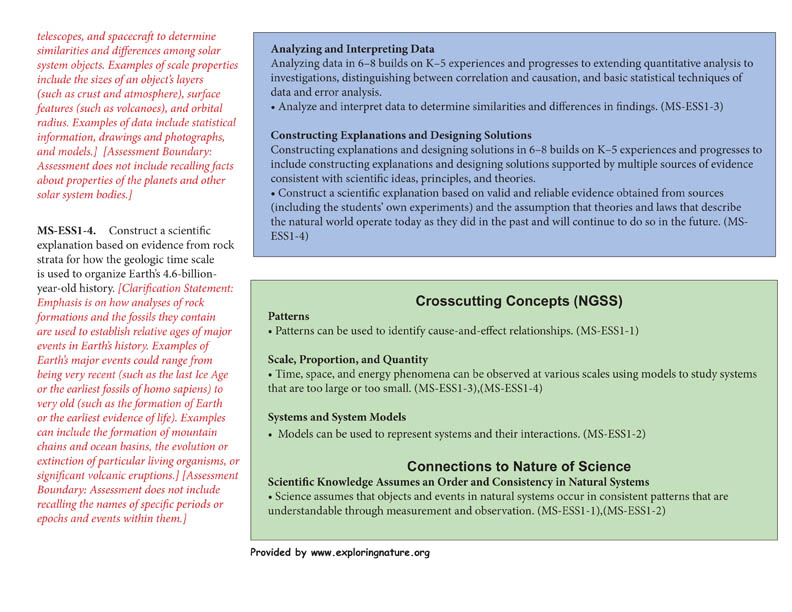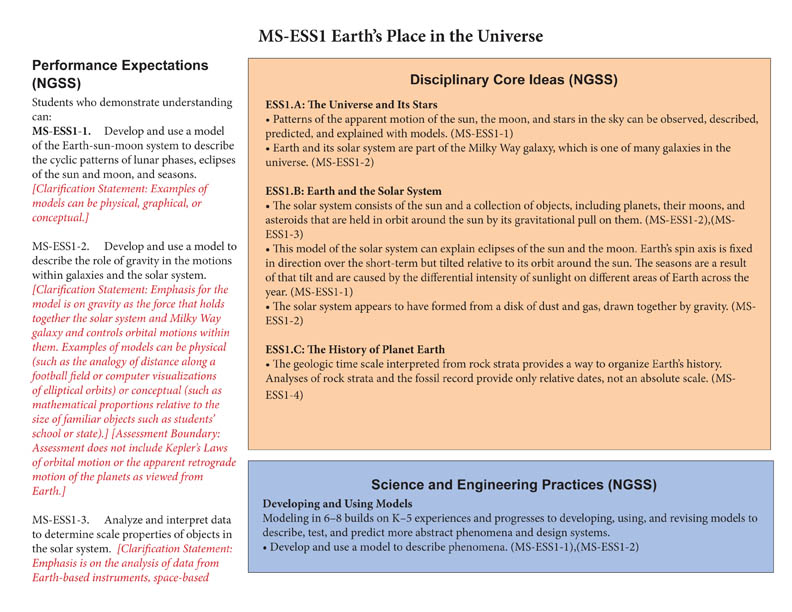

Earth Science for Middle School (Grade (6-8th)
LINKS to content and activities to help fulfill the Next Generation Science Standards shown below.
ESS1.A: The Universe and its Stars
ESS1.B: Earth and the Solar System
New Generation of Science Standards (NGSS)
Disciplinary Core Ideas
ESS1.A: The Universe and Its Stars
• Patterns of the apparent motion of the sun, the moon, and stars in the sky can be observed, described, predicted, and explained with models. (MS-ESS1-1)
• Earth and its solar system are part of the Milky Way galaxy, which is one of many galaxies in the universe. (MS-ESS1-2)
ESS1.B: Earth and the Solar System
• The solar system consists of the sun and a collection of objects, including planets, their moons, and asteroids that are held in orbit around the sun by its gravitational pull on them. (MS-ESS1-2),(MS-ESS1-3)
• This model of the solar system can explain eclipses of the sun and the moon. Earth’s spin axis is fixed in direction over the short-term but tilted relative to its orbit around the sun. The seasons are a result of that tilt and are caused by the differential intensity of sunlight on different areas of Earth across the year. (MS-ESS1-1)
• The solar system appears to have formed from a disk of dust and gas, drawn together by gravity. (MS-ESS1-2)
ESS1.C: The History of Planet Earth
• The geologic time scale interpreted from rock strata provides a way to organize Earth’s history. Analyses of rock strata and the fossil record provide only relative dates, not an absolute scale. (MS-ESS1-4)
Science and Engineering Practices
Developing and Using Models
Modeling in 6–8 builds on K–5 experiences and progresses to developing, using, and revising models to describe, test, and predict more abstract phenomena and design systems.
• Develop and use a model to describe phenomena. (MS-ESS1-1),(MS-ESS1-2)
Analyzing and Interpreting Data
Analyzing data in 6–8 builds on K–5 experiences and progresses to extending quantitative analysis to investigations, distinguishing between correlation and causation, and basic statistical techniques of data and error analysis.
• Analyze and interpret data to determine similarities and differences in findings. (MS-ESS1-3)
Constructing Explanations and Designing Solutions
Constructing explanations and designing solutions in 6–8 builds on K–5 experiences and progresses to include constructing explanations and designing solutions supported by multiple sources of evidence consistent with scientific ideas, principles, and theories.
• Construct a scientific explanation based on valid and reliable evidence obtained from sources (including the students’ own experiments) and the assumption that theories and laws that describe the natural world operate today as they did in the past and will continue to do so in the future. (MS-ESS1-4)
Crosscutting Concepts
Patterns
• Patterns can be used to identify cause-and-effect relationships. (MS-ESS1-1)
Scale, Proportion, and Quantity
• Time, space, and energy phenomena can be observed at various scales using models to study systems that are too large or too small. (MS-ESS1-3),(MS-ESS1-4)
Systems and System Models
• Models can be used to represent systems and their interactions. (MS-ESS1-2)
Connections to Nature of Science
Scientific Knowledge Assumes an Order and Consistency in Natural Systems
• Science assumes that objects and events in natural systems occur in consistent patterns that are understandable through measurement and observation. (MS-ESS1-1),(MS-ESS1-2)
Performance Expectations
Students who demonstrate understanding can:
MS.Structure, Function, and Information Processing
MS-LS1-1. Develop and use a model of the Earth-sun-moon system to describe the cyclic patterns of lunar phases, eclipses of the sun and moon, and seasons. [Clarification Statement: Examples of models can be physical, graphical, or conceptual.]
MS-ESS1-2. Develop and use a model to describe the role of gravity in the motions within galaxies and the solar system. [Clarification Statement: Emphasis for the model is on gravity as the force that holds together the solar system and Milky Way galaxy and controls orbital motions within them. Examples of models can be physical (such as the analogy of distance along a football field or computer visualizations of elliptical orbits) or conceptual (such as mathematical proportions relative to the size of familiar objects such as students’ school or state).] [Assessment Boundary: Assessment does not include Kepler’s Laws of orbital motion or the apparent retrograde motion of the planets as viewed from Earth.]
MS-ESS1-3. Analyze and interpret data to determine scale properties of objects in the solar system. [Clarification Statement: Emphasis is on the analysis of data from Earth-based instruments, space-based telescopes, and spacecraft to determine similarities and differences among solar system objects. Examples of scale properties include the sizes of an object’s layers (such as crust and atmosphere), surface features (such as volcanoes), and orbital radius. Examples of data include statistical information, drawings and photographs, and models.] [Assessment Boundary: Assessment does not include recalling facts about properties of the planets and other solar system bodies.]
MS-ESS1-4. Construct a scientific explanation based on evidence from rock strata for how the geologic time scale is used to organize Earth’s 4.6-billion-year-old history. [Clarification Statement: Emphasis is on how analyses of rock formations and the fossils they contain are used to establish relative ages of major events in Earth’s history. Examples of Earth’s major events could range from being very recent (such as the last Ice Age or the earliest fossils of homo sapiens) to very old (such as the formation of Earth or the earliest evidence of life). Examples can include the formation of mountain chains and ocean basins, the evolution or extinction of particular living organisms, or significant volcanic eruptions.] [Assessment Boundary: Assessment does not include recalling the names of specific periods or epochs and events within them.]
When you research information you must cite the reference. Citing for websites is different from citing from books, magazines and periodicals. The style of citing shown here is from the MLA Style Citations (Modern Language Association).
When citing a WEBSITE the general format is as follows.
Author Last Name, First Name(s). "Title: Subtitle of Part of Web Page, if appropriate." Title: Subtitle: Section of Page if appropriate. Sponsoring/Publishing Agency, If Given. Additional significant descriptive information. Date of Electronic Publication or other Date, such as Last Updated. Day Month Year of access < URL >.
Amsel, Sheri. "MS-ESS1: Earth’s Place in the Universe" Exploring Nature Educational Resource ©2005-2024. December 20, 2024
< http://www.exploringnature.org/db/view/1931 >


